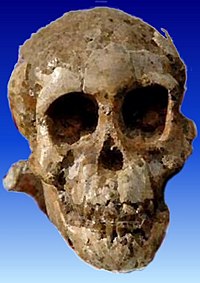Let's begin with the fossils I suppose, as the visual representations speak very strongly about this matter.
Now, when we talk about the evolution of human beings, many people often ask the question, "wait a minute.. are you saying we come from Chimpanzees?!" This of course is inaccurate, as we share a common ancestor with Chimps, who are our closest cousins as it regards species. We don't know exactly which species was the common ancestor, but it seems to have been the Sahelanthropus tchadensis. (Pictured below)
Let's compare to a human and chimp skull.
View attachment 5428
As you can see, the braincase is even larger on the Chimpanzee, but distinct similarities can be seen from the front of the face such as the brow ridge.
View attachment 5429
The change is much more drastic when compared to a human skull, as our jaws don't need to be as powerful as a chimpanzees, and our braincase far exceeds that of our late 7 million year old ancestor.
Fast forwarding a bit, we have the Australopithecus afarensis, which we know was a bipedal (walked on two legs) primate. The similarities became more distinct as this is an ancestor we do not share with any other living species today.
This is the skull of a female that was 3 years old, which you have to take into account that they didn't develop as slowly as we do, hence the skull and teeth are relatively developed. The braincase is still quite smaller, but the overall shape is distinct from that of other known primates, but certainly couldn't have been human.
Fast forwarding even more, I want to go to one of the most complete fossils we have in human evolution and mention the Turkana Boy, which is a fossil of Homo ergaster or Homo erectus, depending on who you are talking to. This fossil was discovered in 1984 in Kenya, and is remarkable.
The similarities to modern humans now really start to be on display, and some might even mistake this for a Homo sapien if they didn't know any better. There are some distinct differences, such as narrower hips, longer arms and of course a much smaller brain. Here below is a facial reconstruction, to give you some idea of what they would have looked like.
View attachment 5430
Certainly you would conclude that this is not a human, nor did they share any of our distinctiveness as it comes to our ingenuity. Over a period of nearly 2 years and they hardly progressed in terms of technological development or societal structure.
That's a little bit to discuss, and I wanted to keep this simple and show some of the fossils that we have, of which there are many.









